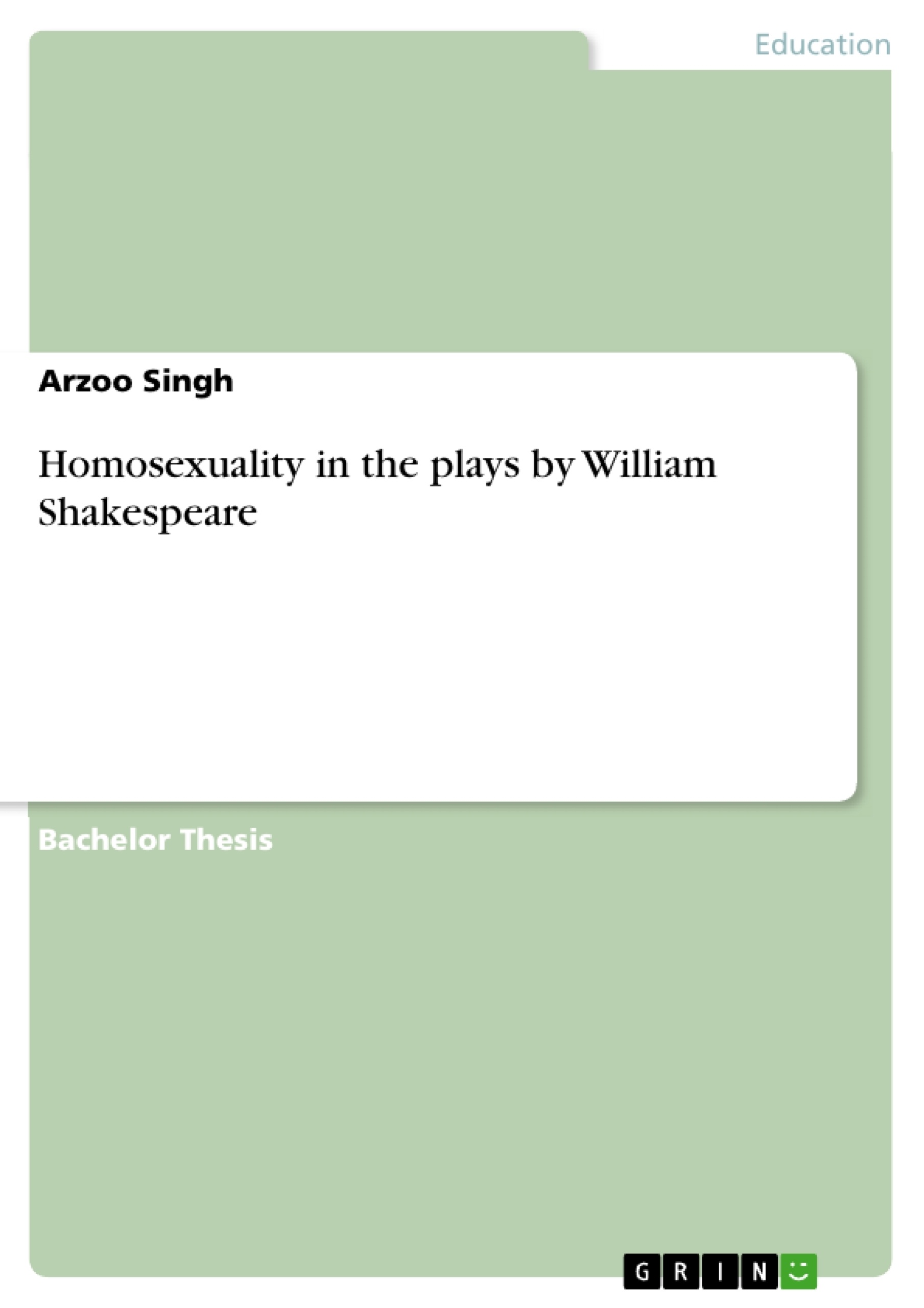This Research paper aims at highlighting various homo sexual instances in four of Shakespeare’s Comedies - A Midsummer Night’s Dream, As You Like It, The Merchant of Venice and Twelfth Night. When I discuss "levels" of relationships, I refer to one of three levels: the first is the playhouse level, which denotes the Early Modern theatrical world and assumes the use of boy actors.
The second level is the true-character level, which signifies the "true plot" that lies under the exterior plot where characters do not yet know that Cesario is actually Viola or that Ganymede is actually Rosalind. The third and final level is the plot level, or what is currently occurring in the story line at that moment without invoking the playhouse level or citing the use of boy actors.
I also refer to other works of Shakespeare like his sonnets and his plays (Romeo and Juliet, Henry IV and V, Troilus and Cressida, Othello, Timon of Athens and Tragedy of Coriolanus) and try to determine the disruption of hetero-normative Renaissance England by homo-erotic characters developed by Shakespeare. In this paper, I also shed light on the Playwright’s life and the socio-cultural environment of Elizabethan England. The difference between the societies of then and now is highlighted and are accordingly used to interpret the plays.
Table of Contents
- ABSTRACT
- INTRODUCTION
- LITERATURE REVIEW
- SIGNIFICANCE OF THE RESEARCH
- LIMITATIONS OF THE RESEARCH
- CONCEPTUAL FRAMEWORK AND METHODOLOGY
- HOMOSEXUAL INSTANCES IN SHAKESPEARE'S COMEDIES
- HOMO-EROTIC INSTANCES IN SHAKESPEARE'S OTHER WORKS
- CONCLUSION
- REFERENCES
Objectives and Key Themes
This research paper explores the presence of homosexual instances in Shakespeare's works, specifically focusing on four comedies: "A Midsummer Night's Dream," "As You Like It," "The Merchant of Venice," and "Twelfth Night." The paper examines the different levels of relationships within the plays, considering both the playhouse level, where boy actors were used, and the true-character level, where the hidden identities of characters are revealed. It also analyzes homo-erotic instances in other Shakespearean works, including sonnets and plays like "Romeo and Juliet," "Henry IV and V," "Troilus and Cressida," "Othello," "Timon of Athens," and "Tragedy of Coriolanus."
- Homosexuality in Shakespearean plays
- Levels of relationships in Shakespeare's works
- Homo-erotic instances in Shakespeare's works
- The socio-cultural environment of Elizabethan England
- The impact of homosexuality on the hetero-normative society of Renaissance England
Chapter Summaries
- Abstract: Provides an overview of the research paper's aims, scope, and methodology. It introduces the four comedies being analyzed and outlines the three levels of relationships explored. The abstract also mentions the analysis of other Shakespearean works and the exploration of the socio-cultural context of Elizabethan England.
- Introduction: Defines homosexuality as a sexual orientation and discusses its historical context, particularly in 17th-century England. It highlights the prevailing societal views and laws regarding sexuality at the time.
- Literature Review: Examines existing scholarship on homosexuality in Shakespeare's works. It provides a critical overview of relevant studies and theories, setting the stage for the author's own analysis.
- Significance of the Research: Explains the importance of studying homosexuality in Shakespeare's works, emphasizing its relevance to contemporary discussions about sexuality and identity.
- Limitations of the Research: Acknowledges any limitations of the research, such as potential biases or limitations in the available data. It provides a transparent assessment of the study's scope and potential shortcomings.
- Conceptual Framework and Methodology: Outlines the theoretical framework and research methods employed in the study. It clarifies the concepts, definitions, and research approaches used to analyze the chosen texts.
- Homosexual Instances in Shakespeare's Comedies: Examines specific instances of homosexuality in the four chosen comedies. It analyzes the characters, their relationships, and the ways in which they challenge or reinforce the norms of Elizabethan society.
Keywords
The paper explores themes of sexuality, gender, identity, and theater history. It analyzes the use of boy actors in Elizabethan theater and examines how Shakespeare's plays contribute to contemporary discussions about LGBTQ+ issues.
- Quote paper
- Arzoo Singh (Author), 2017, Homosexuality in the plays by William Shakespeare, Munich, GRIN Verlag, https://www.grin.com/document/416717




